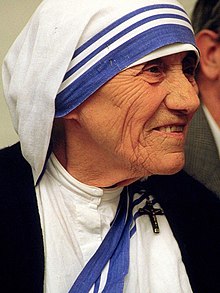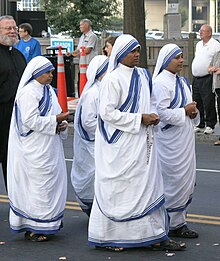Overview: Mother Theresa’s Missionaries of Charity
Missionaries of Charity

Mother Teresa, founder of the Missionaries of Charity.

Sisters belonging to Missionaries of charity in their attire of traditional white sari with blue border.
Missionaries of Charity is a Roman Catholic religious congregation established in 1950 by Blessed Mother Teresa of Calcutta. It consists of over 4,500 religious sisters and is active in 133 countries. Members of the order designate their affiliation using the order’s initials, “M.C.” A member of the Congregation must adhere to the vows of chastity, poverty, obedience, and the fourth vow, to give “Wholehearted and Free service to the poorest of the poor”.
Today, the order consists of both Contemplative and Active Branches of Brothers and Sisters over several different countries. In 1963, both the Contemplative branch of the Sisters and the Active branch of the Brothers were founded, Brothers being co-founded by then Australian Jesuit (who became Brother Andrew, M.C.) Fr Ian Travers-Ball S.J.[1] In 1979 the Contemplative branch of the Brothers was added and in 1984 a priest branch, the Missionaries of Charity Fathers,[2] was founded by Mother Teresa with Fr. Joseph Langford, combining the vocation of the Missionaries of Charity with the Ministerial Priesthood. As with the Sisters, the Fathers live a very simple lifestyle without television, radios or items of convenience. They neither smoke nor drink alcohol and beg for their food. They make a visit to their families every five years but do not take annual holidays.[3]Lay Catholics and non-Catholics constitute the Co-Workers of Mother Teresa, the Sick and Suffering Co-Workers, and the Lay Missionaries of Charity.
Missionaries care for those who include refugees, ex-prostitutes, the mentally ill, sick children, abandoned children, lepers, people with AIDS, the aged, and convalescent. They have schools run by volunteers to educate street children, they run soup kitchens, as many other services as per the communities’ needs. They have 19 homes in Kolkata (Calcutta) alone which include homes for women, for orphaned children, and for the dying; an AIDS hospice, a school for street children, and a leper colony. These services are provided, without charge, to people regardless of their religion or social caste.
In 1990, Mother Teresa asked to resign as head of the Missionaries, but was soon voted back in as Superior General. On March 13, 1997, six months before Mother Teresa’s death, Sister Mary Nirmala Joshi was selected the new Superior General of the Missionaries of Charity. Sister Mary Prema was elected to succeed Sister Nirmala during a general chapter held in Calcutta in April 2009.[4]
Contents |
Foundation
On October 7, 1950, Mother Teresa and the small community formed by her former pupils was labeled as the Diocesan Congregation of the Calcutta Diocese, and thus received the permission from the Vatican to exist as a Church subject. Their mission was to care for (in Mother Teresa’s words) “the hungry, the naked, the homeless, the crippled, the blind, the lepers, all those people who feel unwanted, unloved, uncared for throughout society, people that have become a burden to the society and are shunned by everyone.” It began as a small community with 12 members in Calcutta, and today it has over 4,500 Sisters running orphanages, AIDS hospices, charity centres worldwide, and caring for refugees, the blind, disabled, aged, alcoholics, the poor and homeless and victims of floods, epidemics and famine in Asia, Africa, Latin America, North America, Europe and Australia.
In 1965, by granting a Decree of Praise, Pope Paul VI granted Mother Teresa’s request to expand her congregation to other countries. The Congregation started to grow rapidly, with new homes opening all over the globe. The congregation’s first house outside India was in Venezuela, and others followed in Rome and Tanzania, and eventually in many countries in Asia, Africa, and Europe, including Albania. In addition, the first home of the Missionaries of Charity in the United States was established in the South Bronx, New York. By 1996, the Congregation was operating 517 missions in more than 100 countries and today is assisted by over one million co-workers and many donations from ordinary people.
Becoming a Missionary of Charity
It takes nine years to become a full fledged Missionary of Charity. At the beginning, anyone interested in the life can come for a short term “come-and-see” experience. If the young women still wish to join and are still considered possible candidates by the Congregation, they enter Aspirancy, focused on learning English (which is the community language) for those who are not from English-speaking countries and deepening of their Christian life. It is followed by Postulancy (introduction into the study of the Sacred Scripture, the Constitutions of the Society, Church history, and Theology. If found suitable, they enter the Novitiate, which is the true beginning of the religious life. Novices wear white cotton habit with a girdle and white saris without the three blue stripes. In the first year (called canonical), they deepen their life of prayer and relationship with God along with their knowledge of life as a Missionary of Charity, the second year is more focused on the practical training for the mission life. After two years, they take temporary vows for one year, which are renewed annually (five years in total). They also receive the blue striped sari of the Congregation and a metal crucifix as a sign of their spousal love for Christ. In the sixth year, they travel to Rome, Calcutta or Washington D.C. for “Tertianship”, a year of deep spiritual growth, at the end of which they make their final profession.
A Sister’s possessions include: three saris (one to wear, one to wash, one to mend), two or three cotton habits, a girdle, a pair of sandals, a crucifix and rosary. They also have a plate, a set of cutlery, a serviette, a canvas bag, and prayer book. In cold countries, possessions also include a cardigan and other suitable items according to the local conditions (a coat, scarf, shoes etc).
Controversy
The quality of care offered to terminally ill patients in the Homes for the Dying has been criticised in the medical press, notably The Lancet and the British Medical Journal (BMJ). They reported the re-use of hypodermic needles[citation needed], poor living conditions, cold baths for all patients, and an approach to illness and suffering that ignores such elements of modern medical care as systematic diagnosis.[5] Dr. Robin Fox, editor of The Lancet, described the medical care as “haphazard”, as volunteers without medical knowledge made decisions about patient care because of the lack of doctors. He observed that the Congregation did not seem to distinguish between curable and incurable patients, so that people who could otherwise survive would be at risk of dying from infections and lack of treatment.[6] The spending of the donations has also been criticised. The author and journalist Christopher Hitchens and the German magazine Stern have alleged that Mother Teresa did not focus the money on alleviating poverty or improving the conditions of her hospices, but on opening new convents and increasing missionary work.[7]
